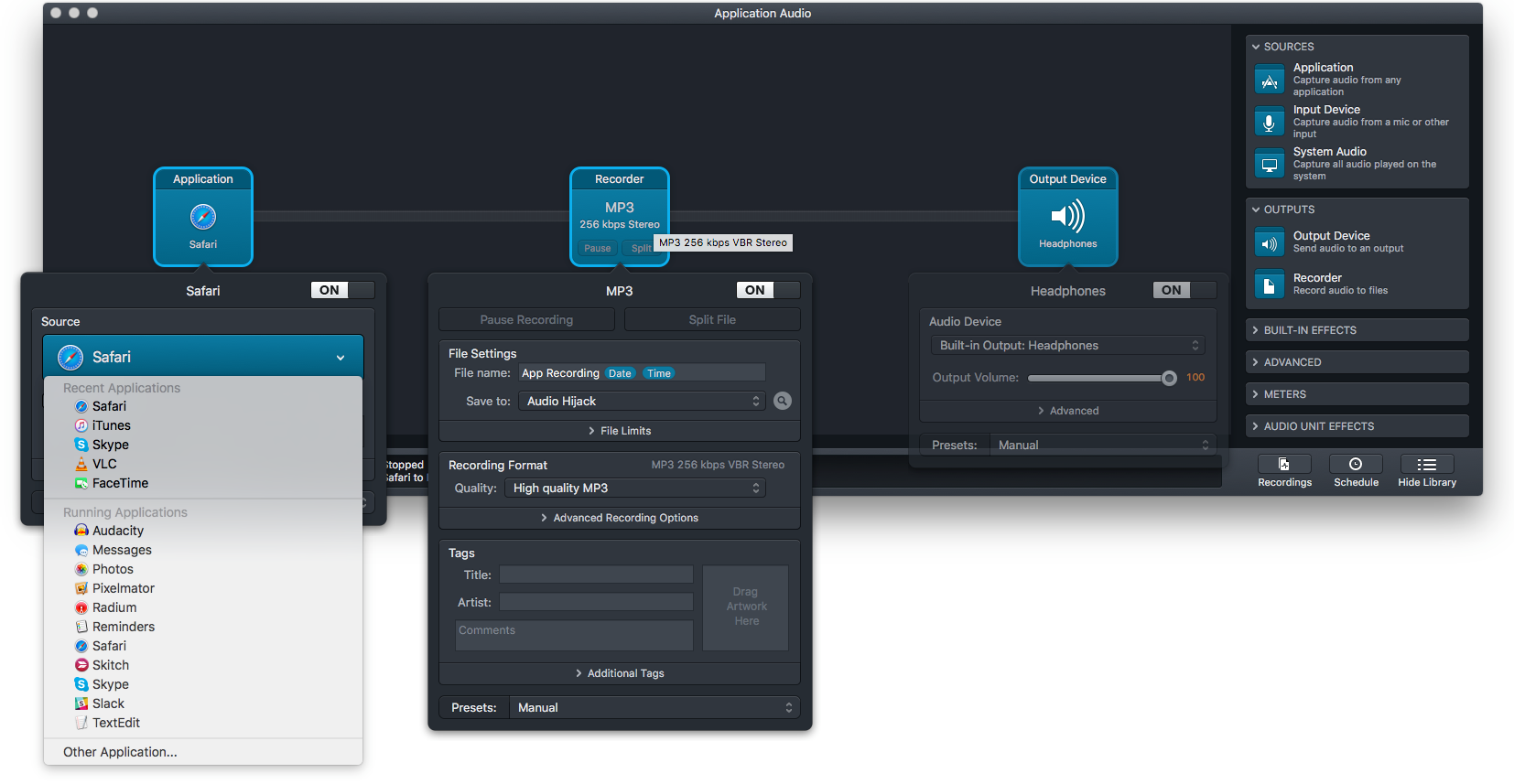Recently, Rogue Amoeba released a new version of its Audio Hijack Pro software. This latest version, Audio Hijack 3, has a very different interface from previous versions.
The download version of Audio Hijack for Mac is 3.8.4. Audio Hijack antivirus report. This download is virus-free. This file was last analysed by Free Download Manager Lib 6 days ago. Google Safe Browsing. Often downloaded with. Jason Snell reviews Audio Hijack 3, the new version of Rogue Amoeba’s popular audio app for OS X: Audio Hijack’s mastery of a Mac’s disparate audio inputs and outputs is amazing. OS X itself is pretty poor when it comes to this stuff—you can set a single input and output in the Sound preference pane.
Audio Hijack 3 Functionality and Accessibility
Audio Hijack 3 lets you record audio directly to your Mac, and save the recording as a file. It can record from Skype, Safari, a microphone, and other audio sources. Download 123d design mac. Some podcasters use it for recording their podcasts, although it is not actually an audio editor.
Rogue Amoeba has consistently designed its Audio Hijack software to have good VoiceOver accessibility. Although the new program isn't perfect in this regard, it is very good.
Getting Help

When either the trial or the purchased app loads, two options are presented: 'Dive Right In' and 'Read the Manual.' The manual is accessible using VoiceOver. Although descriptions and information refer to clicking buttons on the screen, these tasks are accessible with the keyboard. There is also a link to the app's Help Center. Audio Hijack 3 also has an extensive onboard Help menu that includes the manual, support contact form, and link to the knowledge base. You can also visit the Rogue Amoeba online support page. All tech support is provided via e-mail.
Using the App
If you have a previous version of Audio Hijack, you will have the option to import your old sessions into Audio Hijack 3. For example, if you recorded Skype conversations, the template you used can be imported.
Layout
Audio Hijack 3 looks very different from previous versions. Along with keyboard commands, the screen can be explored with the VO keys along with the Left and Right Arrow keys. There are some tabs, but no toolbar.
When the application is opened, by default you will be placed on the 'New Session' button. This button can also be accessed with Command + N. The 'Delete Recording' button is to the right of the 'New Session' button. Along with the Apple Menu and the Audio Hijack 3 menu there are the Session, Edit, Control, Window, and Help Menus. The Session menu has two options: New Recording and Open Recording. The Edit menu is the standard edit menu. The Control menu has options to Start, Stop, Pause, and Split a recording. These menus are easy to navigate.
There are three tabs on the screen and all can be accessed with keyboard commands. The first tab is Sessions (Command + 1); any imported recordings will be found here. The Up and Down Arrow keys can be used to review the list. Command + 2 will bring you to the next tab, Recordings, where actual recordings are located. You can view your recordings either in Finder or from within the application. The final tab is Scheduled (Command + 3), where you can schedule recordings. Tabs are selected with checkboxes.
Making a Recording
In previous versions of Audio Hijack, you selected a recording option, such as to record from Skype or Safari, from a table. In the new version, you can either select an imported session or activate the 'New Session' button (Command + N). A Template Chooser will open and there will be a list of many recording options. Each option also has a Help tag. After using the Arrow keys to navigate to an item, wait a few seconds to hear the help read aloud. Examples of available templates are: New Blank Session, Voice Chat, Web Audio, and System Audio. The Blank Session template lets the user create his or her own configuration for recording a session. The Voice Chat template is used for recording conversations such as with Skype. The Web Audio template is designed to record any kind of audio, such as music or a podcast, directly from Safari. The System Audio template will record whatever sound is coming from your Mac, including VoiceOver. Once you select a template, focus should move to the Audio Grid. If it doesn't, move left and VoiceOver will indicate when you're in the Audio Grid.
The Audio Grid
The audio grid is a new feature. It gives the user a lot of flexibility when choosing how to record a session. For many users, the templates provide all necessary configurations.
Each component of a recording session is called an audio block. For example, the Web Audio template has three audio blocks: Safari, MP3, and Internal Speakers. In other words, the Safari audio will be recorded as an MP3 file and played through my Mac's internal speakers. Think of the grid as a piece of graph paper with the X-axis going horizontally and the Y-axis going vertically. VoiceOver will speak each audio block with X and Y coordinates. After a few seconds, VoiceOver will also speak the Help tag associated with the specific audio block.
The audio grid is used to change settings. Typing VO + Spacebar on the file type (in this example, MP3) and then moving right will bring up many sections including File Settings and Recording Format. Interact with the particular session, review the contents of each session, and make your selection. Golf with friends free mac download.
Audio Hijack 3 Pause Recording
Adding Audio Blocks
If using one of the pre-configured templates or a previously imported session, you have the option to add additional audio blocks. If you're creating a session from a blank template, it is necessary to add the various audio blocks. If you're in the Audio Grid, stop interacting and VO + Right Arrow to navigate to the list of Audio Blocks. Interact with the list and arrow down through the various categories of blocks. Choose the category and then the specific audio block. Press VO + Spacebar to go back to the Audio Grid.
There are many ways to move blocks, but the easiest way to add a new block is to interact with the block. Next, paste the new block on top of the original block. The old block will move to the right and the new block will be inserted before it. Blocks can be moved with Command or Option and the Left and Right Arrow keys. VoiceOver will speak the block's position as it is moved. When moving blocks it's important to know that any two blocks cannot be moved more than 45 degrees apart. Pasting the new block automatically ensures the angle is correct.
Once the Audio Grid is configured, type Command + R to start recording. By using the VO keys with the Left and Right Arrow keys, you can check recording time and locate the checkbox to pause recording. The recording is automatically saved to the Audio Hijack folder created by the application. If you don't want to keep the recording, there is a 'Delete Recording' button in the application.
Conclusion
The new format for Audio Hijack 3 can be a bit confusing. Fortunately, it contains many pre-configured templates. VoiceOver provides a lot of information including Audio Grid position and Help tags.
There is a free trial version available if you're not sure that you want to purchase the application. The free trial lets you record for 10 minutes at a time. If you decide to purchase the application, you'll receive a license key that will allow you to unlock the full program.
Below are some excellent podcasts that explain Audio Hijack 3 in even greater detail. Remember that you don't have to create or modify any of the templates if the ones provided meet your needs.
Podcast Resources
In this podcast, Alex Hall explains the Audio Grid and how to create a session.
Jonathan Mosen provides a detailed description of Audio-Hijack 3, including how to make changes to an audio block and how to choose a template.
In this episode, Dr. Robert Carter and Allison Hartley speak with Grant Farr, the Rogue Amoeba developer responsible for the Audio Hijack user interface, including the excellent VoiceOver support.
Product Information
Product: Audio Hijack 3 by Rogue Amoeba
Cost: $49 (an upgrade from Audio Hijack Pro to Audio Hijack 3 costs $25). A free trial download is also available.
Comment on this article.
Audio Hijack 3 Keygen
Related articles:
More from Janet Ingber:
Download Audio Hijack 3.8 for Mac full version program setup free. Audio Hijack is a lightweight yet powerful program that helps you to record any application’s audio, including VoIP calls from Skype, web streams from Safari, and much more. Java decompiler mac download.
Audio Hijack 3.8 for Mac Review
Audio Hijack is an accessible application that you can use to record any application’s audio. This comprehensive application specially developed for recording sounds from various devices. Gamers, YouTubers, Vloggers, and other audio masters can use it for recording their desired sounds. It comes with a straightforward layout that offers quick access to the files and folders stored on your computer, so you can easily select the ones to process.
Audio Hijack 3 Mac
The recording process is very simple and short as you just need to set any application as your source in Audio Hijack, then hit the record button to save its audio. Using Audio Hijack 3, users can also capture and record audio from microphones, mixers, web Streams, Skype, FaceTime, Google Talk, or any other VoIP service and Podcast. There is no restriction of audio format as it empowers users to record to all major formats including MP3 and AAC, or save in perfect-fidelity AIFF, WAV, ALAC or FLAC. To sum it all up, Audio Hijack 3 is a must-have program for recording and enhancing the audio with great ease.
Features of Audio Hijack 3.8 for Mac

- A perfect program for recording any application’s audio
- Captures and record audio from microphones and mixers
- Can record VoIP calls from Skype and web streams from Safari
- Stream to RTMP servers like YouTube Live, Twitch, and Periscope
- Enables users to send audio to Shoutcast and Icecast servers
- Allows to pause, delay, and rewind live audio on Mac
- Record to the world’s most popular audio formats
Technical Details of Audio Hijack 3.8 for Mac
- Software Name: Audio Hijack 3
- Software File Name: AudioHjack-3.8.zip
- File Size: 28 MB
- Developer: RogueaMoeba
System Requirements for Audio Hijack 3.8 for macOS
- macOS 10.10 or later
- 50 MB free HDD
- 512 MB RAM
- Intel Core 2 Duo or higher
Audio Hijack 3.8 Free Download
Click on the button given below to download Audio Hijack 3.8 free setup. It is a complete offline setup of Audio Hijack 3 for macOS with a single click download link.
